The content of the article
There are quite a lot of shchitomordniki, but in today's material we will consider the copper-headed representative of the family. He is ranked among the pit snakes, which are distinguished by their toxicity and bloodthirstiness. Leading herpetologists of the world attribute the type of reptiles under discussion to the most insidious species that live in the vastness of North America. They appear when you are not waiting for them and do not ask to be seen. Let's study the main characteristics in order of priority.
Description
- This variety of reptiles cannot be called bulky, but this fact does not make them less dangerous. The muzzle length extends up to 1.3 m along the body. Maximum, but smaller representatives are often found.
- The body is sealed and powerful, the tail is shortened, covered with shields in the lower section. At the end there are keratinized and rough areas of the skin. The head is in the format of an irregular triangle, there are borders separating the head from the cervical region.
- The upper part of the head is moderately flat, but not flattened. There is a recess above the upper lip, the mouth opens wide due to the presence of an incision. Behind the occipital section, non-keel type flaps stand out. According to the color of the case, the following can be said: brown shades with a copperish sheen prevail. However, that's why the snake got its name.
- The case itself is painted red-brown. In the upper section, there are shields with a fringing and transverse stripes, this whole pattern imitates the accumulation of a large number of arcs. Cross strips look advantageous on the back, so the reptile is called moccasin.
- These very elongated inclusions are combined in a chaotic manner with spots of irregular shape. This pattern extends all the way to the middle of the tail. In the natural environment, snakes can be found that are pigmented in orange or pink with dark stripes.
- The case in the lower section is light with a red or copper tint. There are patterns consisting of many triangles and spots. The final color directly varies from what age a particular individual is, where it lives, how it feeds, etc. Reptiles of this species are multifaceted in terms of their pigmentation.
- The head is always lighter than the rest of the body. Its characteristic feature is a revealed and wide strip. The head on the lateral parts is dark, the strip itself extends along the upper lip.
- It was previously mentioned that these individuals are bloodthirsty. But they don’t eat themselves. Exterminate insects, in particular caterpillars, locusts and cicadas. Kill birds and their eggs, as well as rodents. Attack without warning.
Habitat
- The individuals of the breed species discussed live in the United States of America in the east and south. Forgiven territorial distribution up to Nebraska and central Texas.
- The habitat of reptiles is difficult to predict, because they are present everywhere. They love larch, pasture, sparse terrain, shrub plantations, etc.
- More courageous representatives of the genus live in gardens and vegetable gardens, near the city and settlements, near rivers and a wetland. Numerous snakes in bamboo thickets.
Characteristics
- A characteristic feature of the considered individuals is that they attack without any warning. The bite itself causes severe pain. The poison is not dangerous for humans, but in the place of a bite, inflammatory processes begin to develop almost immediately.
- As mentioned earlier, the presented reptiles are not poisonous.However, it is unusual that they fall without warning due to their temperament. Unfortunately, one can never predict the movements of an individual under discussion.
- Therefore, if you suddenly encounter such a snake, the result will most likely not be the best for you. The properties of the poison are very similar to the poison of rattlesnake, only toxicity is manifested to a much lesser extent. In general, a bite can worsen significantly.
- Naturalists recall the case that after a bite of the individual in question, a horse died a few hours later. If you study other sources, cases of a bite of such a snake were recorded many times, a person did not end badly from this. In addition, on hot sunny days, reptiles try to hide in shady places.
Behavior
- When the predator begins to approach, the copper-headed muzzle insect immediately takes a defensive stance. The advantage of such snakes is that their movements are several times faster than rattlesnakes. However, muzzles are a little lazy.
- Otherwise, the behavior of the considered reptiles is not much different from other poisonous snakes. As for hunting, muzzles do this during daylight hours. The snake usually raises its head slightly, pulls out its tongue and makes a little noise with the tip of its tail.
- Separately, it is worth mentioning that the discussed individuals do not produce an attack, curled up in a ring or in a lying position. Copperhead muzzles are dangerous only when they take an S-shape. The instincts of the poisonous reptile do not disappear, even if the snake has been living in captivity for a long time.
Captivity
- Despite the fact that such snakes are poisonous, they are kept in captivity. If you observe caution and follow simple rules, you can keep this individual in a closed terrarium.
- It must be of sufficient size. It is better to use coconut flakes as a substrate. Be sure to install a drinker and a lamp for heating. Also need a house and driftwood.
If you are going to keep this individual in captivity, you should study all the subtleties. The content of a poisonous snake is not the most reasonable solution. As for feeding, it is best to give striped geckos and rodents to reptiles.

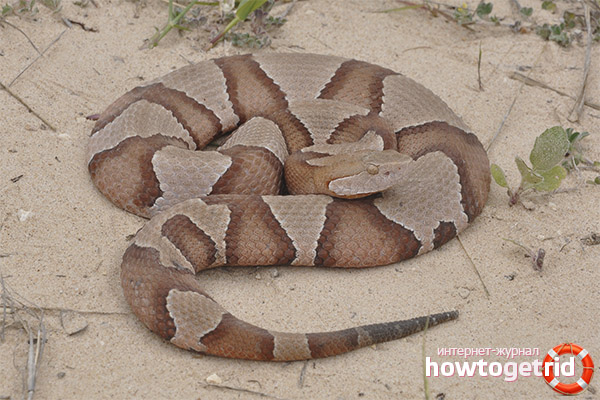
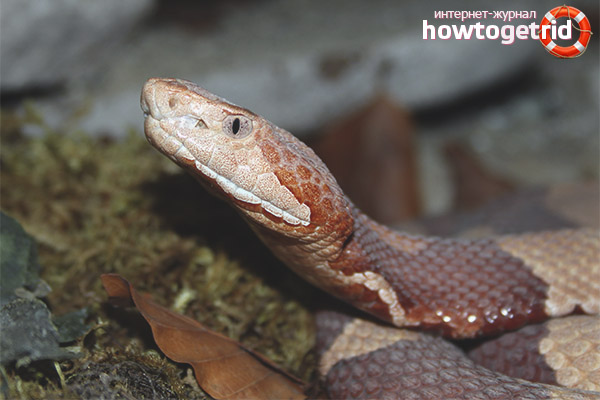

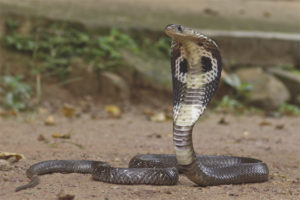
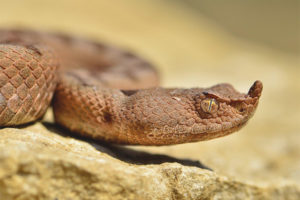
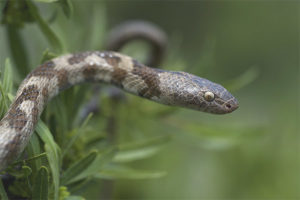
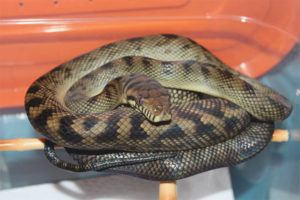
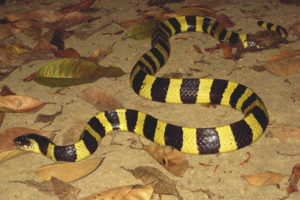

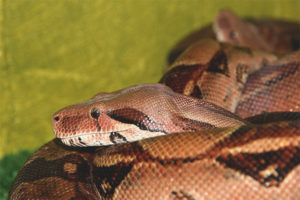
Submit